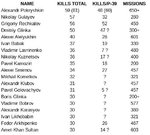DarrenW
Staff Sergeant
Three of the five top Soviet aces (Grigori Rechkalov, Nikolai Gulaev and Dmitri Glinka) got most of their kills while flying P-39s and Rechkalov and D. Glinka ended the war in May 1945 still flying P-39s with Guards units operating inside Germany. Gulaev was badly wounded in Aug 44, still flying P-39 with 129 GIAP. And at least still in March 1945 Airacobras operated with Leningrad area PVO with Guard interceptor units. So guard units used P-39s to the end of the war in Europe in air superiority and interceptor roles.
Juha
Thanks Juha for the valuable information. Through your research were you able to ascertain the overall validity of the "kills" awarded to these top Soviet fighter pilots? And how much, if any, were their scores "influenced" by the Soviet propaganda machine?

